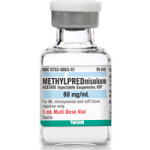 During the latter part of 2012, we reported on the meningitis outbreak that was affecting hundreds and hundreds Americans in dozens of states across our nation. And although the number of meningitis cases has slowed, there are still people being affected by the contamination of the injection that caused all this trouble, as the number of spinal infections near the injection site is on the rise.
During the latter part of 2012, we reported on the meningitis outbreak that was affecting hundreds and hundreds Americans in dozens of states across our nation. And although the number of meningitis cases has slowed, there are still people being affected by the contamination of the injection that caused all this trouble, as the number of spinal infections near the injection site is on the rise.
Michigan, a state that accounted for more than one third of all cases, was hit harder than all the other states. And no hospital has treated more patients than St. Joseph Mercy of Ann Arbor, which has had 53 cases of meningitis and more than 100 spinal infections, according to The New York Times.
None of the patients were infected at the hospital; all were among 643 people who received the tainted injections at one nearby private clinic, Michigan Pain Specialists, in Brighton.
The drug, methylprednisolone acetate, made by the New England Compounding Center in Framingham, Mass. was contaminated with a fungus, and was injected near the spine to treat chronic back or neck pain and caused a nationwide meningitis outbreak and spinal infections.
As of December, 620 people in 19 states have fallen ill, most with meningitis or spinal infections, or both; 39 have died. Infections inside joints have also occurred. Nearly all the illnesses have been caused by a black mold called Exserohilum. The treatment is a long course of antifungal drugs, which can have dangerous side effects.
The spinal infections can be dangerous and hard to detect. At least 200 have occurred, and more are expected because nearly 14,000 people had injections from tainted lots of the drug.
The Centers for Disease Control and Prevention urged doctors to look harder for these infections — to consider M.R.I. scans even in patients who did not feel worse after the injection, but whose existing back or neck pain simply did not get better. This advice was more aggressive than previous recommendations, which had called for scans only if patients had new or worsening symptoms. The new message could lead to thousands of additional scans, and will almost certainly find new cases.
“We know we’re not out of the woods,” said Dr. Tom M. Chiller, the deputy chief of the mycotic diseases branch of the C.D.C. “People could still be harboring or developing infections in their spines now.”
Harold Rye, 73, a retired autoworker in Maybee, Mich., had meningitis and then a spinal infection. He was hospitalized twice, for a total of 43 days, and needed two operations. Before the illness he was strong and active, a gardener and deer hunter. Now, he said in an interview, “I’m so weak I can’t walk through the house without stumbling.”
Blurred vision, from voriconazole, keeps him from driving, and he thinks the drug is causing mental confusion, too. There seems to be no end in sight.
“They can’t give me a clean bill of health,” he said.
Mr. Rye along with others have hired lawyers to sue New England Compounding.
Doctors at St. Joseph Mercy were the first to recognize that spinal infections were becoming a major problem.
The hospital took a bolder step than the C.D.C. has ever recommended: Its doctors decided that every patient exposed to the contaminated drug should be offered an M.R.I. scan of the injection site to look for abscesses and other signs of infection.
Though the infections can cause severe pain, they can also lurk in the spinal area and produce few or no symptoms, the scans revealed. They can take months to become apparent. Often an initial M.R.I. is negative, and later ones positive. A significant number of the scans are equivocal, and the doctors generally wait and repeat them, to avoid using the toxic drugs unless they are really needed.
In many cases, patients cannot distinguish pain that might be due to an abscess from the chronic pain that drove them to seek steroid shots in the first place. But whether the infections cause pain or not, they should be treated with drugs and possibly surgery, doctors say. Untreated, the infections can damage nerves and bone, and the fungus might even eat its way through the protective membranes around the spinal column, invade the brain and cause meningitis.
